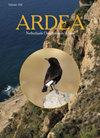温暖的冬季增加了波兰波美拉尼亚湖区鹅的繁殖成功率
IF 1.3
4区 生物学
Q3 ORNITHOLOGY
引用次数: 2
摘要
北半球物种通常通过从其分布的南部边缘撤出并将繁殖地向北转移来应对全球变暖。然而,欧洲的鹅尾秋沙鸭繁殖种群的情况似乎是矛盾的:在许多地方,繁殖种群的增加和范围的扩大都有记录。我们在1987年至1996年的繁殖季节研究了该物种的繁殖生物学。我们表明,在冬季之后,当冰盖更早消失时,在波兰北部繁殖的古桑德种群的繁殖成功率更高。冰盖的消失与离合器启动日期呈正相关,早期窝的繁殖成功率较高。总体平均离合器启动日期为4月13日±15天(SD)。离合器启动日期的年度平均值从4月初到5月初不等。除其他因素外,古桑德在繁殖时间方面的适应性可能是该物种在过去30年中扩展到新地区的部分原因。本文章由计算机程序翻译,如有差异,请以英文原文为准。
Warmer Winters Increase the Breeding Success of the Goosander in the Pomeranian Lake District in Poland
Northern Hemisphere species generally respond to global warming by withdrawing from the southern margins of their distributions and shifting their breeding sites northwards. However, the situation regarding the breeding populations of Goosanders Mergus merganser merganser in Europe appears to be paradoxical: in many places, an increase in the breeding population and range extension have been documented. We studied the breeding biology of this species during the breeding seasons of 1987–1996. We show that the breeding success of a Goosander population breeding in Northern Poland was higher following winters when the ice cover disappeared earlier. There was a significant positive relationship between the disappearance of ice cover and the clutch initiation date, and the breeding success of early broods was higher. The overall mean clutch initiation date was 13 April ± 15 days (SD). The yearly means of clutch initiation dates varied from the beginning of April to the beginning of May. It seems likely that, among other factors, the Goosander's adaptability in terms of the timing of breeding may be partially responsible for the expansion of the species into new areas in the last 30 years.
求助全文
通过发布文献求助,成功后即可免费获取论文全文。
去求助
来源期刊

Ardea
生物-鸟类学
CiteScore
2.10
自引率
0.00%
发文量
49
审稿时长
>12 weeks
期刊介绍:
Ardea is the scientific journal of the Netherlands Ornithologists'' Union, and is published since 1912. The journal welcomes manuscripts reporting significant new findings in ornithology, in particular those covering the ecology, life history, and evolution of birds, and including sound descriptive work. Ardea publishes Original research papers, Short notes and Book reviews. In addition to the regular three issues per year, Ardea publishes specials that contain conference or workshop proceedings (produced on request).
 求助内容:
求助内容: 应助结果提醒方式:
应助结果提醒方式:


